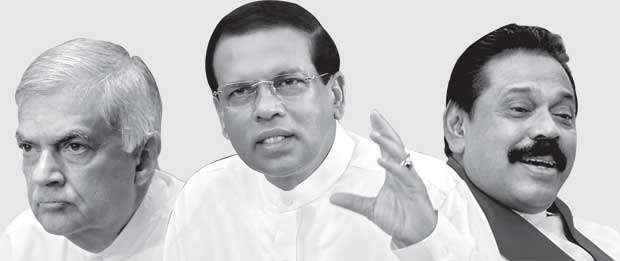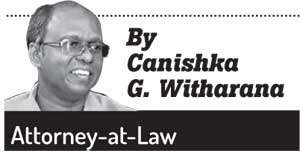Reply To:
Name - Reply Comment
Last Updated : 2024-04-20 15:01:00

 he United States (US) and European Union (EU) have issued statements requesting the Government to act according to the constitution. However, Ranil Wickremesinghe continues to pursue his claim as the Prime Minister and that his removal was unconstitutional. Both the removal and the new appointment are published in the Government Gazette.
he United States (US) and European Union (EU) have issued statements requesting the Government to act according to the constitution. However, Ranil Wickremesinghe continues to pursue his claim as the Prime Minister and that his removal was unconstitutional. Both the removal and the new appointment are published in the Government Gazette.
Articles (sections/Art) herein are as amended by the 19th Amendment to the Constitution.
There are two possible arguments establishing the correctness and the constitutionality of the act of the President in appointing Mahinda Rajapaksa as the Prime Minister.
The President is the Head of the State, Head of the Executive and of the Government, and the Commander-in-Chief of the Armed Forces (Art.30). He gets executive power directly from the people at the Presidential Election. People’s Sovereign power of franchise is exercised at the election of the President (Art.4) Sovereignty of the people is inalienable (Art.3). The People entrust executive power to the President with the expectation that he would use such powers for their benefit: This is a fundamental duty and the responsibility of the President. The Constitution vests in the president the authority to decide the best manner in which such powers are to be executed through the machinery of the Government. Therefore, the constitution confers sole authority on the President (the head of Government) to decide as to the composition of the Cabinet of Ministers.
power directly from the people at the Presidential Election. People’s Sovereign power of franchise is exercised at the election of the President (Art.4) Sovereignty of the people is inalienable (Art.3). The People entrust executive power to the President with the expectation that he would use such powers for their benefit: This is a fundamental duty and the responsibility of the President. The Constitution vests in the president the authority to decide the best manner in which such powers are to be executed through the machinery of the Government. Therefore, the constitution confers sole authority on the President (the head of Government) to decide as to the composition of the Cabinet of Ministers.
The Cabinet of Ministers is charged with the direction and control of the Government (Art. 42(1). The cabinet is collectively responsible and answerable to Parliament (Art. 42(2). The President is a member and also the Head of the Cabinet (Art. 42(3). In order to empower the President with the maximum liberty and authority, the constitution vests in him the discretion to decide the Prime-Minister. Article 42(4) provides as follows:
“The President shall appoint as Prime Minister the Member of Parliament, who, in the President’s opinion, is most likely to command the confidence of Parliament”
The opinion of the President cannot be questioned or tested. He is expected to evaluate the prevailing condition and decide the person in the best interest of the people and the country. The President is expected to take into consideration all the circumstances and information at his hand in formulating his opinion.
He who has apparent authority to “Command parliament” may not be the same person who can “command the confidence” of Parliament. In the present scenario, Ranil Wickremesinghe claims that Parliamentary majority is still with him. He does it by taking a physical count of the number of parliamentarians of his party. He assumes that he has the commanding authority over his party members of parliament.
On the other hand the President may have evaluated the confidence of the members on different grounds. He can consider other sources of information such as intelligence reports to do a practical evaluation. In other words the constitution expects the President to apply as an objective test in formulating his opinion. Finally the President seems to have held the opinion that Mahinda Rajapake (MR) commands the confidence of Parliament.
The correctness of President’s opinion can be witnessed with the increasing number of UNP members declaring their willingness to support MR. “Confidence” in the constitution is based on the ‘free will’ of the members. Such ‘confidence’ reflected in Article 42(4) is different from the number of party parliamentarians on whom an artificial force a leader of a party may employ.
The best precedent is the appointment of RW (himself) in January 2015, when UNP was still having only few seats in the Parliament. Ranil was appointed even without officially removing the incumbent Prime Minister, D. M. Jayaratne. Ranil accepted the portfolio without any allegation of any procedural unconstitutionality. Thereafter the new cabinet was appointed. Today he faces the same situation as Jayaratne did in 2015. Therefore RW is stopped from criticizing the same procedure as unconstitutional, from which he benefitted in 2015.
Logically there cannot be two members in the parliament who can command the confidence of Parliament simultaneously. Therefore, with the appointment of MR as the Prime Minister, the removal of RW happens automatically. Principles of interpretation of laws provide that whenever any law gives powers to appoint, it includes the powers to remove also. This principle is embodied into section 14(f) of the Interpretation Ordinance of Sri Lanka.
Therefore it is clear that the President has lawfully appointed MR as the Prime Minister in terms of Article 42(4) of the Constitution read with section 14(f) of the Interpretation Ordinance.
When the Prime Minister ceases to hold office by removal or otherwise, the Cabinet of Ministers shall become dissolved by operation of Article 48. However, there is a crucial discrepancy between the Sinhala and English texts of the Constitutions. The word “removal” is stated only in the Sinhala text. When there is an inconsistency between two texts, the law directs to consider the Sinhala version as prevailing over the English text. The act of “removal” of PM can only be done by the President. Such removal is constitutionally recognized in Articles 47 and 48 (Sinhala text). Therefore with the publication of the Gazette removing RW from the office of Prime Minister, the Cabinet also became dissolved by operation of Article 48. Therefore there is no cabinet of ministers functioning under the premiership of RW from October 26, 2018.
Ranil Wickremesinghe seems to be relying on Article 46(2) of the constitution, which reads as follows;
“The Prime Minister shall continue to hold office throughout the period during which the Cabinet of Ministers continues to function under the provisions of the Constitution unless he-
(a) Resigns his office by a writing under his hand addressed to the President; or
(b) Ceases to be a Member of Parliament”.
It is argued – prima facie-that this Article leaves no room here to remove the Prime Minister. Even if Article 46(2) was treated in isolation, still it is subject to the condition “throughout the period during which the Cabinet of Ministers continues to function...” It means once the cabinet was dissolved(for whatever reason) the Prime Minister too would cease to hold office by operation of law.
Until October 26, 2018, Sri Lanka was governed by a (purported) “National Government”, which was created with the passing of the following resolution of the Parliament on September 3, 2015.
“Whereas the UNP, which obtained the highest number of seats in Parliament has formed a National Government, Parliament determines in terms of Article 46(4) of the Constitution of the Democratic Socialist Republic of Sri Lanka that the number of Ministers in the Cabinet of Ministers shall not exceed 48 and the number of Ministers who are not Cabinet Ministers and the number of Deputy Ministers shall not exceed 45.”
“National Government means a Government formed by the recognized political party or the independent group which obtains the highest number of seats in Parliament together with the other recognized political parties or the independent groups” (Art. 46(5).
The previous cabinet exceeded the limit of 30 under the authority of the Parliament obtained under the aforesaid resolution passed in terms of Article 46(4) of the Constitution. The largest constituent party joined UNP to form the national government was SLFP, which again is a constituent of UPFA. On October 26, 2018, the UPFA withdrew from the national government. As a result the Parliamentary sanction granted under Article 46(4) to the UNP to maintain a cabinet of ministers above the limit of 30 also came to an end. In such circumstances, the cabinet of Ministers ceased to have constitutional authority to function from October 26, 2018. Accordingly in terms of Article 46(2), Ranil Wickremesinghe, Prime Minister (of the National Government) discontinued to hold office from that date.
Therefore in the absence of a Prime Minister and a Cabinet of Ministers the President had no legal obstacle to appoint Mahinda Rajapaksa as the next Prime Minister of Sri Lanka.
As the present portfolios are structured to meet the requirements of a National Government, they have to be redefined in compliance with Article 43(1) to meet conditions of a non-National Government. In doing so, the President has to consult the Prime Minister. President appoints ministers on the advice of the PM (Art 43(2). The President will not incline to consult or get advice from Ranil as his recognition as PM is now ended. President has already issued official advice to the state officials confirming the dissolution of the previous cabinet of ministers.
Therefore, the appointment of Mahinda Rajapaksa as the new Prime Minister is both lawful and consistent with the constitution. On the other hand there is no legal basis in the claims of Ranil Wickremesinghe.

Add comment
Comments will be edited (grammar, spelling and slang) and authorized at the discretion of Daily Mirror online. The website also has the right not to publish selected comments.
Reply To:
Name - Reply Comment
On March 26, a couple arriving from Thailand was arrested with 88 live animal
According to villagers from Naula-Moragolla out of 105 families 80 can afford
Is the situation in Sri Lanka so grim that locals harbour hope that they coul
A recent post on social media revealed that three purple-faced langurs near t